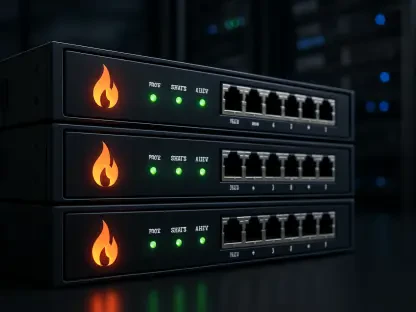In an era where cyber threats are becoming increasingly sophisticated and pervasive, Zero Trust Network Architecture (ZTNA) has emerged as a transformative force in cybersecurity, fundamentally altering how organizations protect their digital assets. Unlike traditional security models that assume trust within a network perimeter, ZTNA operates on the uncompromising principle of “never trust, always verify,” requiring continuous authentication and validation of every user, device, and connection, regardless of their origin or prior access. This shift is not merely a technological trend but a critical response to the escalating risks of data breaches, ransomware, and insider threats that plague businesses worldwide. As remote work and cloud adoption redefine operational landscapes, the demand for a security framework capable of addressing these dynamic challenges has skyrocketed. The ZTNA market, valued at USD 4.65 billion in 2024, is projected to reach USD 30 billion by 2035, reflecting a compound annual growth rate (CAGR) of 18.4%. This remarkable trajectory underscores a global recognition of ZTNA as an essential safeguard in today’s interconnected digital ecosystem.
Forces Driving the Rapid Adoption of ZTNA
The meteoric rise of ZTNA can be attributed to the alarming increase in cyber threats that have outpaced the capabilities of conventional security approaches. Sophisticated attacks such as ransomware, phishing, and insider breaches have exposed glaring vulnerabilities in perimeter-based defenses, compelling organizations to embrace a model that prioritizes identity verification and strict access controls. This urgency is amplified by the sheer volume of sensitive data now handled digitally, where a single breach can result in catastrophic financial and reputational damage. ZTNA’s ability to scrutinize every interaction within a network, regardless of location, provides a robust layer of protection against these evolving risks. Moreover, regulatory pressures from frameworks like GDPR and HIPAA are pushing companies to adopt stringent data protection measures, further cementing ZTNA as a cornerstone of compliance strategies across industries.
Beyond the threat landscape, the transformation of workplace dynamics plays a pivotal role in ZTNA’s global surge. The widespread shift to remote and hybrid work environments, accelerated by global events in recent years, has dispersed employees and devices across diverse locations, rendering traditional network boundaries obsolete. Coupled with the rapid adoption of cloud services and the proliferation of Internet of Things (IoT) devices, the attack surface has expanded dramatically. ZTNA addresses these challenges by enforcing granular oversight and continuous monitoring, ensuring secure access to corporate resources from any endpoint. This adaptability is particularly vital for enterprises navigating multi-cloud and hybrid infrastructures, where seamless integration of security protocols is non-negotiable. As businesses increasingly prioritize flexibility without compromising safety, ZTNA stands out as the framework best equipped to balance operational needs with stringent cybersecurity demands.
Barriers Hindering Widespread Implementation
Despite its undeniable benefits, the adoption of ZTNA is not without significant challenges that can slow its integration into organizational frameworks. One of the most prominent obstacles is the complexity and cost associated with deployment, particularly for small and medium-sized enterprises (SMEs) operating with limited budgets and technical expertise. Implementing ZTNA often requires a complete overhaul of existing security architectures, a process that can be both resource-intensive and disruptive. For many businesses, especially those reliant on legacy systems, achieving compatibility with zero trust principles demands substantial investment in infrastructure upgrades and specialized tools. This financial burden, coupled with the time required for a smooth transition, often deters organizations from fully committing to this transformative approach, even when the long-term benefits are clear.
Additionally, a critical shortage of skilled cybersecurity professionals poses a formidable barrier to ZTNA adoption. Designing, deploying, and managing zero trust frameworks require specialized knowledge that is currently in short supply within the global talent pool. Many organizations struggle to find experts capable of navigating the intricacies of ZTNA, leading to delays in implementation or suboptimal setups that fail to deliver the intended security outcomes. Resistance to change further complicates the landscape, as some enterprises remain entrenched in familiar but outdated security models, hesitant to embrace a paradigm shift. Balancing rigorous security measures with user experience also remains a concern, as overly strict controls can frustrate employees and hinder productivity. Addressing these human and operational challenges through training, awareness, and vendor-supported solutions is essential to broadening ZTNA’s reach across diverse sectors.
Sectoral and Geographic Adoption Patterns
When examining the industries leading ZTNA adoption, sectors like Banking, Financial Services, and Insurance (BFSI) and healthcare stand out as frontrunners due to their handling of highly sensitive data and stringent regulatory requirements. In BFSI, the need to protect financial transactions and customer information against cyber threats drives heavy investment in zero trust solutions, ensuring that access to critical systems is tightly controlled. Similarly, healthcare organizations, bound by laws like HIPAA, rely on ZTNA to safeguard patient records and maintain compliance amidst a landscape of increasing digital health services. These industries illustrate how the urgency of data protection, combined with legal mandates, accelerates the integration of zero trust architectures, setting a benchmark for others to follow as cyber risks continue to mount across all sectors.
Geographically, the ZTNA market reveals distinct patterns of growth and dominance that reflect varying levels of technological maturity and cybersecurity awareness. North America holds the largest share, fueled by substantial tech investments, robust regulatory frameworks, and a proactive stance on digital security in countries like the United States and Canada. Europe follows closely, with data protection laws such as GDPR driving adoption in nations like the UK and Germany. However, the Asia-Pacific region is emerging as the fastest-growing market, propelled by rapid digital transformation and rising cyber threats in economies like China and India. Even regions like Latin America and the Middle East & Africa are witnessing increased demand, as growing IT spending and frequent cyber incidents push financial and public sectors toward ZTNA. These regional disparities highlight the diverse catalysts shaping the global embrace of zero trust principles.
Competitive Innovation Shaping the Market
The ZTNA market is a hotbed of competition, with industry giants like Zscaler, Microsoft, Cisco, and Palo Alto Networks spearheading advancements that redefine cybersecurity standards. These companies are continuously enhancing their offerings, integrating cutting-edge technologies such as AI-driven threat detection and cloud-native access solutions to address the nuanced needs of modern enterprises. For instance, the development of platforms that combine zero trust with Secure Access Service Edge (SASE) frameworks reflects a trend toward comprehensive, unified security models that support distributed networks. This relentless push for innovation, often through strategic partnerships and product launches, ensures that ZTNA remains at the forefront of defense mechanisms, adapting to new threats and operational demands with remarkable agility.
Moreover, the competitive landscape is characterized by a dynamic interplay of collaboration and expansion among key players, which further accelerates market growth. Mergers, acquisitions, and alliances with cloud providers like Amazon Web Services (AWS) and Google Cloud are enabling vendors to enhance interoperability and scalability of ZTNA solutions. Such initiatives not only broaden the accessibility of zero trust technologies but also foster trust among enterprises seeking reliable, future-proof systems. As these market leaders vie for dominance, their focus on tailoring solutions to hybrid and multi-cloud environments ensures that ZTNA evolves in lockstep with the digital transformation sweeping across industries. This vibrant ecosystem of innovation underscores the pivotal role of competition in driving the global proliferation of zero trust architectures.
Future Steps for Sustaining ZTNA Momentum
Reflecting on the journey of ZTNA, it’s evident that its ascent was fueled by an urgent need to counter sophisticated cyber threats and adapt to the realities of remote work and cloud dependency. The market’s growth, evidenced by projections reaching USD 30 billion by 2035, highlights a collective acknowledgment of zero trust as a vital shield against digital vulnerabilities. Challenges like high costs and skill shortages have been met with persistent efforts from vendors to simplify deployment and offer managed services, ensuring broader accessibility. Key industries and regions have played crucial roles in shaping adoption, setting a precedent for others to emulate.
Looking ahead, sustaining this momentum demands a focus on innovation and education. Stakeholders must prioritize the development of user-friendly, cost-effective ZTNA tools to support smaller enterprises. Investing in training programs to build a skilled workforce will be critical in overcoming talent gaps. Additionally, fostering global collaboration between governments, industries, and tech providers can standardize zero trust practices, ensuring consistent protection across borders. As cyber threats continue to evolve, embracing emerging technologies like AI and automation within ZTNA frameworks will be essential to stay ahead, securing the digital future with unwavering vigilance.









